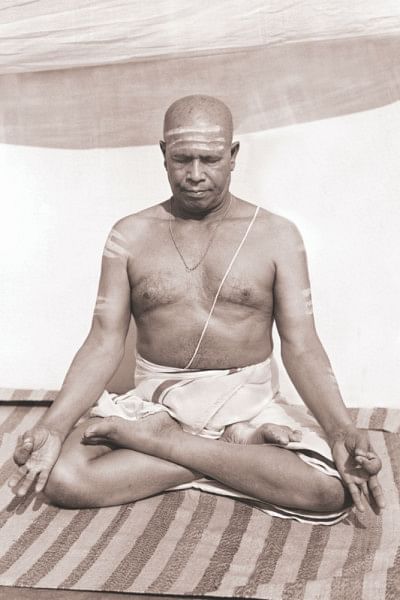The Wisdom of Pattabhi Jois – Ashtanga Yoga Master

Practice, practice, practice, and all is coming - Pattabhi Jois
Pattabhi Jois is considered the father of Ashtanga Yoga as it is practiced now. He began learning at the age of 12 from Krishnamacharya, the father of modern yoga. Krishnamacharya taught both Pattabhi Jois and Iyengar, and from them came Ashtanga and Iyengar yoga respectively.
Before Krishnamacharya, yoga had lost much of its popularity in India due to the oppressive actions of British colonisers. However, Krishnamacharya studied the art in great detail, digging up the Yoga Korunta (ancient text on palm leaves) in the library of Calcutta and piecing together sequences from that. His students, Pattabhi Jois and Iyengar, were successful in not only making yoga popular in India again but also in the West.
Sri Krishna Pattabhi Jois (1915-2009) was born on a full moon day in a village called Kowshika in South India. His father was an astrologer, priest and landholder. His mother took care of the house and nine children, of whom Jois was the fifth. In 1927, Jois attended a yoga demonstration and was amazed by the strength and grace of the yogi. The next morning he asked the yogi, who happened to be Krishnamacharya, to teach him. And so began Jois' 25 year study, first in Kowshika, and later in Mysore where the maharaja, who was a fan of Krishnamacharya, established a yoga shala for yogis.
In 1948, Jois established the Ashtanga Yoga Research Institute, which to this day is considered the leading school of Ashtanga (Sharath, Jois' grandson, teaches there now). In 1975, Jois travelled to California and began demonstrating yoga there. Gradually, over 20 years of visits to America, popularity of yoga grew in the West.
In 1962, Jois wrote a book, Yoga Mala, that has become the treatise of Ashtanga yoga. The rest of this article draws from that book:
Some people fear the practice of yoga, but this is like dismissing sugar before tasting it. Once we taste it, its sweetness becomes apparent. Similarly, once we practice yoga, we come to realise its ananda (bliss).
Ashtanga yoga has eight limbs – yama (external ethics), niyama (internal ethics), pranayama (breathing), asanas (physical poses), pratyahara (drawing away from the senses), dhyana (concentration), dharana (meditation) and finally, samadhi (blissful absorption, or divine union). If these limbs are to be practiced, then care has to be taken to ensure that one does not fall victim to disease, obligation or poverty. For when a person becomes ill, his mind cannot be steady, nor can he do any work. Thus, the body, sensory organs and mind must be stabilised to prevent obstacles. This stability can come from the practice of asanas.
The purpose of yoga is to calm the fluctuations of the mind. This can be done with the help of the breath. When the breath is in motion, the mind is moving. When the breath is steady, the mind is steady. If one's mind is impure and overtaken by "I" and "mine", then one's true nature of bliss will be spoiled. When one's mind is pure, one can experience eternal bliss. To discover the inner self, one can practice yoga.
Only half the stomach should be taken up by food that is eaten. One quarter of the other half should be given over to water and the remaining quarter left to the movement of air. Consuming too much food or no food at all, sleeping too much or not sleeping at all, having too much sexual intercourse– all these should be avoided as much as possible, as they are obstacles to the practice of yoga. Moderation in regards to food and sleep is important.
Yoga should never be learnt from books or looking at pictures. One must learn under the guidance of a teacher or guru who will tailor the practice to the student's bodily constitution. Practicing yoga without proper knowledge of alignment can lead to injury.
Through the practice of yoga, many types of incurable ailments can be cured. This is why yoga is called chikitsa or therapy. Our first duty is to take care of our body, which is our vehicle for the pursuit of a spiritual life. "Yoga" as Pattabhi Jois put it, "is ninety-nine percent practice and one percent theory."
By Shazia Omar
Photo: Collected
Shazia Omar is a yoga instructor at Studio 107. Details about her class schedule are available online. www.shaziaomar.com and she may be reached at [email protected]

 For all latest news, follow The Daily Star's Google News channel.
For all latest news, follow The Daily Star's Google News channel. 



Comments